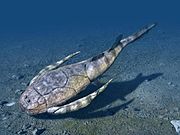| Colombophis | |
|---|---|
|
Scientific classification
| |
| Domain: | Eukaryota |
| Kingdom: | Animalia |
| Phylum: | Chordata |
| Class: | Reptilia |
| Order: | Squamata |
| Suborder: | Serpentes |
| Infraorder: | Alethinophidia |
| Genus: | †
Colombophis Hoffstetter & Rage 1977 |
| Species | |
| |
Colombophis (" snake of Colombia" in Greek) is an extinct genus of snakes of the clade Alethinophidia, a group of "primitive" snakes. The genus was first recognized in the Villavieja Formation in the town of Los Mangos, part of the known fossil fauna of La Venta in the department of Huila ( Colombia), in the middle Miocene. With the remains of a fossil snake was erected the species Colombophis portai in 1977, based on forty fragmentary vertebrae. [1] These vertebrae are characterized by a low neural spine, and subdivided paradiapophysis and thin zygosphene. The vertebrae are medium to large, so the snake would measure about 1.77 metres (5 ft 10 in) long, similar in size to the current Boa constrictor. [2]
Taxonomy
Remains found in the Brazilian Solimões Formation in the Purus River area ( Late Miocene), with vertebrae shorter than wide, thick zygosphene and high neural thorn, were classified as a new species, Colombophis spinosus; [3] fossil remains found in Venezuela ( Urumaco area) and Colombia (La Venta) also seem to belong to this new species rather than C. portai. [3] Traditionally, Colombophis was taken as a representative of the family primitive Aniliidae, fossorial and primitive snakes that still retained some traces of lizard as Anilius, the false coral. However, retention of primitive traits that identify Colombophis and other members of the superfamily Anilioidea (including features already found in the Cretaceous snake Dinilysia patagonica) indicate that this group is paraphyletic and that for now, Colombophis remains as an Alethinophidia of uncertain classification. [3] Moreover, their remains indicate that the ecosystems of South America from the mid-Miocene were humid tropical environments as reinforces the finding of other reptile faunas of Urumaco, La Venta and Solimões as Paradracaena and Eunectes stirtoni; Colombophis, like Dinilysia, must be adapted to move and feed in semi-aquatic environments. [3] Fossils were also found in the Socorro Formation of Venezuela.
References
- ^ Hoffstetter, R. and Rage, J.C. 1977. Le gisement de vertébrés miocènes de La Venta (Colombie) et sa faune de serpents. Annales de Paléontologie (Vertébrés) 63: 161–190.
- ^ Hecht, M.K. and LaDuke, T.C. 1997. Limbless tetrapods. In: R.F. Kay, R.H. Madden, R.L. Cifelli, and J.J. Flynn (eds.), Vertebrate Paleontology in the Neotropics: The Miocene Fauna of La Venta, Colombia, 95–99. Smithsonian Institution Press, Washington.
- ^ a b c d Hsiou, A.S., Albino, A.M., and Ferigolo, J. 2010. Reappraisal of the South American Miocene snakes of the genus Colombophis, with description of a new species. Acta Palaeontologica Polonica 55 (3): 365–379


